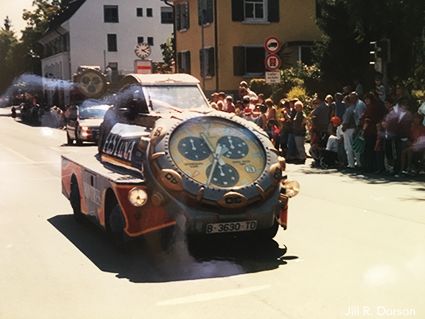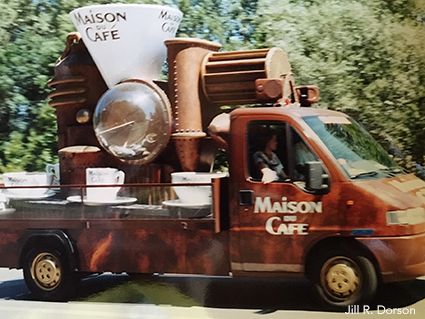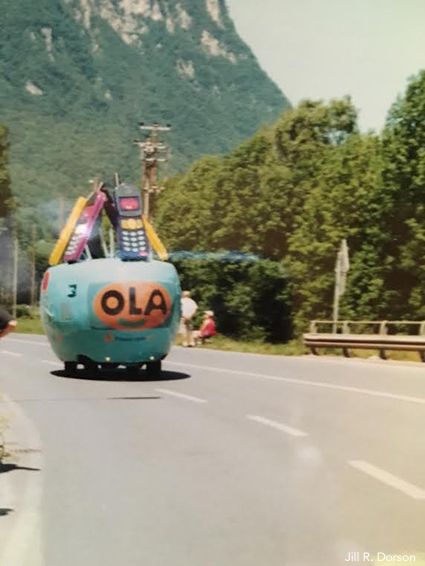The peloton whizzes by in a blur of color, pumping legs and flying water bottles. Or, if you're lucky and on an incline, the thrill lasts a bit longer as cyclists strain to reach the crest, fans running next to them, shouting encouragement.
And while the casual Tour de France viewer may wonder why it is that fans line nearly every foot of the 2,200-mile course, the truth is, the race itself isn't necessarily the main event.
Sure, a chance to see the best cyclists in the world tackling some of the world's most stunning vistas is a rush. But it's the pregame that makes the Tour such a jovial event. The so-called "caravan," a bizarre, hilarious and all-out fun parade that precedes the race itself is cycling's version of tailgating.

Brightly colored floats bearing gaily dressed, enthusiastic pitchmen roll through the Pyrenees, Alps and countrysides tossing snack cakes, packets of coffee, key chains and other tiny trinkets as the world's longest parade snakes it way through France every year.
When the Tour de France began this year at historic Mont St. Michel on July 2, so too did the caravan, which not only lasts longer than the whizzing peloton, but also offers fans a chance to take home a little piece of their experience.
It's been more than 15 years since I stood on the slopes of the Alps in Grenoble, at the site of 1992 Olympics in Albertville and on the outskirts of the quaint spa town of Evian with my husband as we were delighted by the colorful, charming and melodic parade of Lilliputian floats that rolled by for nearly an hour. I can still hear the catchy ditties played by many floats and see the tiny trinkets – key chains, coffee packets and candies – flying through the air as fans scrambled much like they do at Mardi Gras for a tangible piece of the overall experience.
For an American in France, the caravan is as much entertainment as it is an education – some of France's biggest businesses sponsor floats that roll slowly past fans offering a jingle and a trinket.

My favorite float, the Maison du Café offering, featured a larger-than-life espresso maker on the back of a modified pickup truck. Of course, the people driving the truck threw out coffee sampler packets while a jingle blared from the speakers. There was also a float resembling a large ball with giant cell phones on top from Ola as well as an endless array of floats from French banks, mostly tossing candies.
The caravan didn't join the Tour until 1930, 27 years after the first race. But from that first parade, the tradition has stuck and, according to VeloNews, some 50 percent of all Tour de France fans turn out simply to see the caravan. Kids show up with bags to collect treats and trinkets while adults often sing along to the songs blaring from caravan floats. But don’t be fooled, even the adults will elbow to the caravan to grab a hat or coupon.
There can't be anything easy about manning a caravan float. Like the cyclists, those in the caravan must adhere to a strict schedule and the daily drive, enthusiasm and tossing of baubles surely becomes a grind. And those in the caravan likely see little of the race, though they reach each endpoint in plenty of time to watch the cyclists cross the finish line and see the daily podium ceremony.
The caravan was the brainchild of Henri Desgrange, the Tour de France director in 1930. Before that race, teams were run and sponsored by cycling brands, but Desgrange felt there was too much "jockeying" that took away from the individual competition, so he changed the Tour to a country-based format (which remained until 1962 before switching back to the current sponsor-based format).

But according to letour.com, the change was expensive – the Tour took on the cost of supplying food, transportation and lodging for riders – and Desgrange needed a way to finance his idea, so he lobbied France's major companies to take part in his "publicity caravan." France's major brands readily complied, as many were former team sponsors and had lost a key advertising opportunity with the format change.
While the caravan participants have likely changed in the 15 years since my Tour de France experience, the idea behind it hasn't. The caravan features official Tour de France sponsors, including some non-French companies. Among those that have participated in recent years are the water company Vittel, cured sausage maker Cochonou, Banette bakeries and ice-cream maker Cornetto.
In 2015, 34 brands were represented in the caravan, during which 600 people in 154 vehicles threw out 14 million tchotchkes, according to Peloton Magazine.
More By Jill R. Dorson:
-- How Strawberries And Cream Became Wimbledon Tradition
-- Behold The First Running Shoe From Kenya
-- This Nose Tackle Might Be NFL Player Least Likely To Blow His Fortune





